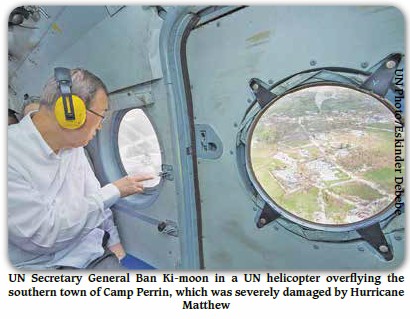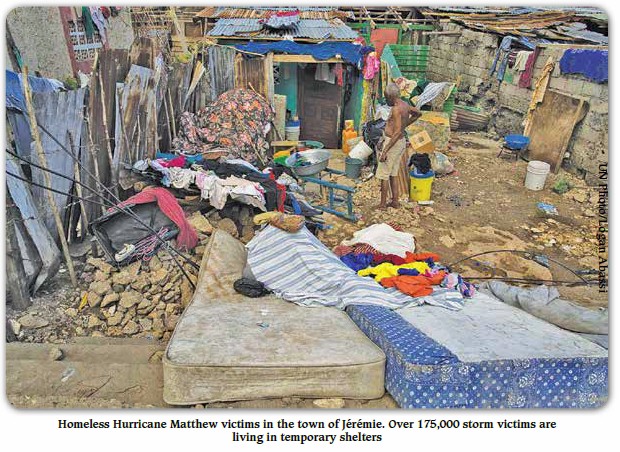|
 Two
days after it said it would, the Provisional Electoral
Council (CEP) finally announced on Oct. 14 Haiti’s new
electoral
timetable. The
presidential and legislative elections that had been
scheduled for Oct. 9, with run-offs on Jan. 8, will now
be held on Nov. 20 and Jan. 29 respectively. The final
results will be announced on Feb. 20, 2017.
Haiti had been hoping to inaugurate a newly
elected president on Feb. 7, 2017, a year after one
should have been inaugurated constitutionally in 2016.
The new 2017 inauguration date, which will be set by
President Jocelerme Privert’s interim government,
has not yet been announced.
The Oct. 9 presidential election, which was to be
a redo of a fraudulent polling
in 2015, had to be rescheduled due to the extensive
damage caused by Hurricane Matthew, which passed
directly over the cities of Les Cayes and Jérémie on
Haiti’s southern peninsula on Oct. 4.
According to an internal Organization of American
States
report dated Oct.
11, of 157 voting centers in Haiti’s southern
department, 112 (71%) were damaged and 29 (18%) were
inaccessible. In the Grande-Anse department,
investigators were able to visit or verify only 26 of
its 106 voting centers. Of those visited, 23 were
damaged, and 31 of the total were inaccessible.
In the Nippes department, investigators visited
or verified 41 of the 85 voting centers and found 22 of
them damaged, while 46 of the total were inaccessible.
Furthermore, many Haitians in the south lost
their homes and their voter identification cards in the
storm. The three hard-hit departments are home to about
1.17 million of Haiti’s 6.19 million registered voters.
There was also storm damage to voting centers and
homes in five of Haiti’s other seven departments, the
report said.
The OAS report warned that repair and
reconstruction of voting centers will be very difficult
“in the medium and long term” because flooding washed
away or damaged many roads and bridges.
Meanwhile, food, clothes, relief supplies, and
construction materials and machinery and have been
streaming into Haiti from
Venezuela and the
Dominican Republic, whose president, Danilo Medina,
visited Haiti on Oct. 10. A convoy of over 500 vehicles
from the DR crossed the border at Jimani/Malpasse on
Oct. 12, but they were accompanied by 1,000 Dominican
soldiers.
Haitians are already outraged by the
Oct. 13 renewal for
six months of a Security Council mandate for 5,000
United Nations troops and police officers (known as
MINUSTAH) to remain in Haiti until Apr. 15, 2017. The
force, originally proposed for six months in 2004, has
now militarily occupied Haiti for over 12 years.
Therefore, the added deployment of Dominican
troops on Haitian soil provoked a sharp nationalist
backlash among Haitians, particularly after a 2013
Dominican law was used to
strip citizenship from and
expel thousands of Dominicans of Haitian
ancestry over the past three years.
But Haitians also jeered a food and water
delivery by UN troops. “As [UN Secretary General] Ban
Ki-moon’s convoy traveled in Aux Cayes for his public
relations tour on Oct. 16, angry Haitians shouted at the
UN trucks, ‘Get out of here! And take your food and
water with you!’,
reported Haitian
journalist Dady Chery for
News Junkie Post.
“Things being as they are with the mainstream press, the
AFP/France 24
translator reported instead that the irate Haitians, who
were in return attacked with tear gas by UN troops, had
demanded food.”
As expected, there has also been an upsurge in
cholera in Haiti’s storm-ravaged south, as detailed in a
poignant front-page
article in the Oct.
16 New York Times. The deadly disease was brought to Haiti by UN
Nepalese troops in October 2010, but the UN did not
begin to admit its responsibility for the epidemic
until this past August.
Unfortunately, the principal response of the UN
and Washington to the post-storm cholera explosion is to
push a supposed cholera vaccine called Sanchol.
“The current promotion of oral cholera vaccines
is a deceitful campaign motivated by pure greed,”
explains Dady Chery,
who is also a U.S. university biology professor.
“Vaccination against cholera in Haiti right now is worse
than useless.
First, even inefficacious vaccines are risky,
because the vaccines used on people in the Third World
usually contain 6 to 30-fold higher concentrations than
the WHO upper limit of
thiomersal, a
mercury-based preservative that might be linked to
autism.
Secondly,
no one knows which cholera bacteria are in Haiti!
The cholera strain identified six years ago has now
changed to the point where vaccines manufactured against
it will not work at all. These vaccines will certainly
be absolutely useless against the strains of cholera
from Bangladesh.
Finally, even under the best circumstances, when
Shanchol is designed and used against a cholera with
recently sequenced DNA, protection is poor to
nonexistent.
A field trial in Bangladesh in 2011 found that
the vaccine conferred only
45% protection in
all age groups after one year, including only about 17%
protection in children under five, who are those most
likely to die from cholera. The results published in
2015 for a field trial in Haiti, passing as a
vaccination and poorly monitored, claimed
57% protection after
one year, but only people older than 12 were
inoculated.”
Given that mass vaccine campaigns offer a huge
money-making opportunity for pharmaceutical companies,
“Haitian authorities should be further advised that some
of the supposed vaccinations might actually be drug
trials for new vaccines,” Dady Chery writes. “This would
be nothing short of experimentation on Haitians as a
large field laboratory.”
Although the electoral campaign season is only
scheduled for 12 days from Nov. 7-18, many candidates
have used the disaster as an opportunity to promote
themselves or their parties.
“[P]residential candidates have fanned out over
the country, delivering aid supplies throughout the
impacted regions,” wrote
Haiti: Relief and
Reconstruction Watch’s Jake Johnston on Oct. 13.
“Many candidates have branded relief supplies with their
political logos. ‘Absolutely, it is to contrast with the
[Haitian] government’ that is seen as absent from many
rural areas, [Roudy] Chute [of former President Michel
Martelly’s Haitian Bald-Headed Party or PHTK] said.
Political ploy or not, a barge with supplies from
private sector actors supporting PHTK arrived in Jérémie
earlier this week and was expected to continue along the
coast, delivering goods to remote coastal towns that
have yet to be reached by aid efforts. [The PHTK did
similar
disaster campaigning
in 2014.] Many of the dump trucks removing debris in
Jérémie bore the PHTK logo next to that of V&F, one of
the largest Haitian construction companies. But PHTK is
far from the only party to take such steps. Jude
Célestin, another of the top candidates and a former
head of the national construction company, has said he
is willing to rebuild a crucial bridge that connects the
south to the rest of the country, and that was
destroyed. His LAPEH party logo was also seen on
construction vehicles in Jérémie. Dr. Maryse Narcisse,
the presidential candidate of the Fanmi Lavalas party,
has led food distributions as well.”
In response to this de facto campaigning, the CEP
put out a
warning on Oct. 12
that “humanitarian aid to victims of Hurricane Matthew
should be an act of non-partisan solidarity. This
gesture cannot be used... as part of an election
process.”
Meanwhile, the Haitian government’s official death toll
from the storm has risen to 546 dead, with 128 missing
and 439 wounded. The Civil Protection Directorate (DPC)
says the government is housing 175,509 storm victims in
temporary shelters.
|